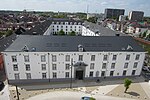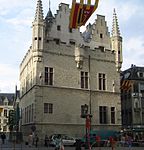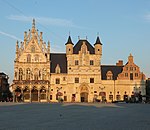Kazerne Dossin Memorial, Museum and Documentation Centre
Buildings and structures in MechelenHistory museums in BelgiumHolocaust museumsMechelenMuseums in Antwerp Province ... and 1 more
Romani in Belgium

The Kazerne Dossin Holocaust memorial is the only part of the Kazerne Dossin: Memorial, Museum and Documentation Centre on Holocaust and Human Rights established within the former Mechelen transit camp of World War II, from which, in German-occupied Belgium, arrested Jews and Romani were sent to concentration camps. The aforementioned museum and documentation centre are housed in a new purpose-built complex across the public square.
Excerpt from the Wikipedia article Kazerne Dossin Memorial, Museum and Documentation Centre (License: CC BY-SA 3.0, Authors, Images).Kazerne Dossin Memorial, Museum and Documentation Centre
Goswin de Stassartstraat, Mechelen
Geographical coordinates (GPS) Address Nearby Places Show on map
Geographical coordinates (GPS)
| Latitude | Longitude |
|---|---|
| N 51.0341 ° | E 4.4785 ° |
Address
Dossinkazerne
Goswin de Stassartstraat 137-149
2800 Mechelen (Mechelen)
Antwerp, Belgium
Open on Google Maps








